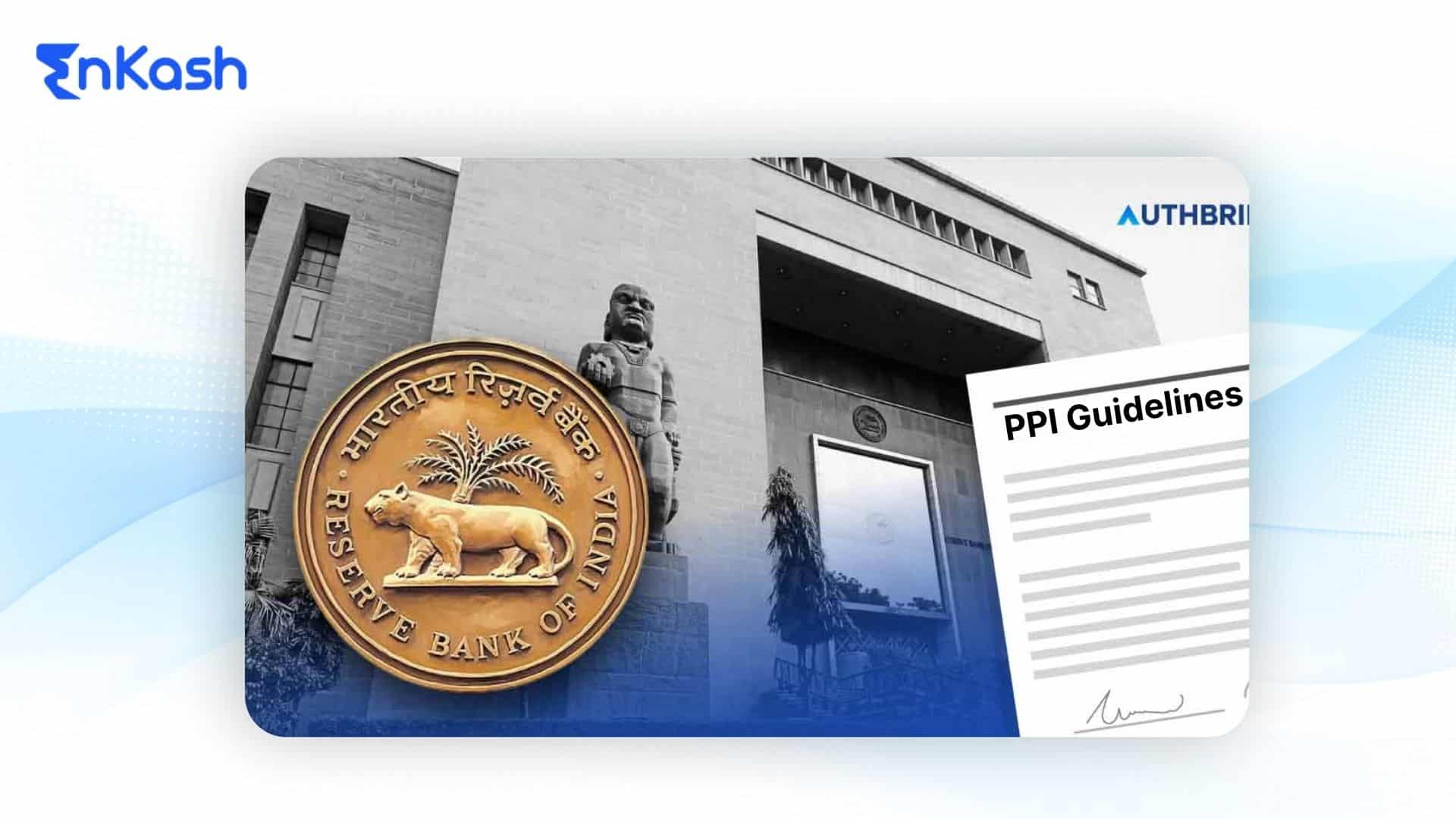Mobile wallets, prepaid cards, and digital vouchers have changed the way people in India pay. These tools all fall under a system the Reserve Bank of India (RBI) calls Prepaid Payment Instruments (PPIs).
RBI has now made important changes to PPI guidelines. It has set fresh limits, updated usage rules, and changed how different types of PPIs are grouped. The goal is to make digital payments more secure, reliable, and easier to manage.
For people who use wallets every day, these rules matter. They help users stay informed, avoid risks, and use digital money with confidence. In a fast-changing payment space, this clarity is key to staying safe and moving forward.
Prepaid Payment Instruments (PPIs): What You Need to Know
Prepaid Payment Instruments are payment instruments that store money in advance. You can use them to pay for goods and services.
A PPI can be digital or physical. You load money into it first, then use it to make payments. Common Prepaid Payment Instrument examples include mobile wallets, prepaid cards, gift vouchers, meal cards, and metro cards.
PPIs make it easier to pay without cash. You can only spend what you’ve already added to them. In India, PPIs are not all the same. The RBI separates them into types based on who provides them and where they can be used. Let’s check out these PPI classifications below.
Closed System PPIs
A closed PPI is issued by a company for use only at that company. You can use it to buy the company’s own products or services. For example, a retailer’s gift card that works only at its own stores is a closed PPI.
Closed PPIs cannot be used at third-party merchants. They also do not allow cash withdrawals.
RBI does not treat closed PPIs as part of the formal payment system. They are not regulated or supervised by the RBI. If the same company issues and redeems the instrument, it is considered “closed-loop.” These fall outside RBI’s regulatory scope.
Semi-Closed System PPIs
Semi-closed PPIs can be used at a set of merchants, both online and offline. These merchants must have an agreement with the PPI issuer.
Most prepaid cards and wallets in India traditionally fell under the semi-closed category, especially before the 2021 classification update. Both banks and non-bank companies can issue semi-closed PPIs. However, they must get authorization from the RBI since the PPIs work across multiple merchants.
Open System PPIs
Open PPIs have the widest usage. You can use them at any merchant that accepts them, for any type of goods or services.
Only banks were allowed to issue open PPIs in the past. A good example is a prepaid travel card from a bank. It works across multiple networks and allows ATM cash-out.
These PPIs work similarly to debit cards. The key difference is that you have to load the money first, then use it.
Read More: RBI allows UPI payments from PPI wallets via third-party applications
RBI’s Revised Classification Framework for PPIs (2021 Onwards)
In August 2021, the RBI introduced a fresh set of directions for Prepaid Payment Instruments. These new guidelines, known as Master Direction, brought all older circulars from 2017 to 2021 under one clear framework.
In addition to the system-based classifications (closed, semi-closed, open), RBI now defines PPIs based on KYC levels and usage scope: Small PPIs and Full-KYC PPIs.
Under this updated setup, any PPI that works across third-party merchants must fit into one of the following categories:
Small PPIs (Minimum-KYC Wallets)
Small PPIs are issued by banks or approved non-bank companies with a PPI license. These are low-value PPI wallets used only for buying goods and services. They work at merchants that are partnered with the PPI issuer. Cash withdrawals and money transfers are not allowed.
There are two types of Small PPIs:
1. Small PPI with Cash Loading
This type lets you load money using both cash and digital methods. It comes with strict PPI limits. The wallet balance can’t go over ₹10,000 at any time. You can load only ₹10,000 per month, with a maximum of ₹1,20,000 per year. You can’t spend more than ₹10,000 in a month. This wallet is valid for up to 24 months from the date of issue. After that, you must upgrade to a Full-KYC wallet to keep using it. If not upgraded, you can still spend the balance, but you won’t be allowed to load any more funds.
2. Small PPI without Cash Loading
This wallet works the same way but does not accept physical cash. You can load money only through a bank account, credit card, or from another full-KYC PPI. Since it doesn’t involve cash, it carries lower risk. These wallets are exempt from the 24-month conversion mandate, as they pose lower risk. However, issuers may impose validity restrictions as per their policies. Many digital wallets fall under this category, as they accept online payments but no physical cash.
Both types of Small PPIs can be reloaded. The cash-loading wallet allows reloading through cash and digital methods.
Full-KYC PPIs
Full-KYC PPIs are an upgraded version of what used to be “open” wallets and fully compliant “semi-closed” ones. These can be used for shopping, money transfers, and even cash withdrawals, all within fixed PPI limits. Such wallets can be reloaded without a monthly cap. The balance can go up to ₹2,00,000 at any time.
There’s no monthly transaction cap. Users can load and spend freely, as long as the total balance stays under ₹2 lakh. Money transfers from full-KYC PPIs to bank accounts or other wallets are allowed. For example, users can send money to another person’s bank or wallet. Transfers to saved (pre-registered) recipients can go up to ₹2,00,000 per month. Transfers to unsaved recipients are limited to ₹10,000 per month. This rule helps prevent fraud and ensures tracking.
Cash withdrawals are allowed. A user can take out money from a PoS terminal or an ATM. The limit is ₹2,000 per transaction and ₹10,000 per month. This applies to both bank and non-bank PPIs. These limits are in place so that cash-outs stay small and don’t bypass banking rules.
Gift PPIs
Gift PPIs are one-time prepaid cards. They can be issued by banks or non-banks with a PPI license. A buyer can purchase one and give it to someone else. The receiver can then use it at selected stores, like in a shopping mall.
The user of the gift card doesn’t need to complete full KYC. However, the person who buys the card must be verified, similar to a minimum-KYC wallet. These cards are not reloadable. Once the loaded amount is used, the card expires. The maximum value allowed for a gift PPI is ₹10,000.
Cash withdrawal and money transfer are not allowed. These cards are meant for small gifting only. They often come with a validity period of one year or more. If the card expires, the user can request revalidation or get a fresh card. The value will not be lost unless left unclaimed for years.
Mass Transit System (MTS) PPIs
These PPIs are used for public transport. They are issued by approved companies for paying metro, bus, or train fares. They also cover services related to transport, like station parking.
MTS PPIs are reloadable. They work like a Metro card, where you recharge and tap to pay. These wallets have a low balance limit. The maximum allowed balance is ₹3,000 at any time. You cannot use these cards to buy regular goods or services. They are only for transport use. Cash withdrawal is not allowed from transit PPIs.
KYC Requirements and Conversion Mandates
The PPI classification depends on the KYC status of the user. Small PPIs only need a minimum KYC. This means a mobile number verification and a basic ID. Full-KYC PPIs need full KYC as per the RBI’s rules. This includes submitting valid documents like PAN or Aadhaar.
RBI wants to make entry easy through small PPIs. But the long-term goal is to move users to full-KYC PPIs for higher usage.
A Small PPI with cash loading must be converted to a Full-KYC PPI within 24 months. After that, users can no longer add money unless they upgrade. This upgrade can be done through Video KYC or other approved digital methods.
A Small PPI without cash loading does not have a time limit. But since it has certain Prepaid Payment instrument limits, many users switch to full KYC if they want to send money or load higher amounts.
Here are the key operational limits as per the RBI:
Maximum Balance
- Small PPIs: ₹10,000
- Full-KYC PPIs: ₹2,00,000
- Gift PPIs: ₹10,000
- Mass Transit PPIs (MTS): ₹3,000
Loading Limits
- Small PPI (cash): ₹10,000 per month, ₹1.2 lakh per year
- Small PPI (no cash):₹10,000 per month, ₹1.2 lakh per year, but only loadable via bank account or card
- Full-KYC PPI: No monthly loading limit (only the ₹2 lakh cap applies)
- Gift PPI: One-time load up to ₹10,000
- MTS PPI: Reloadable as needed, balance must stay within ₹3,000
Usage Restrictions
- Small PPIs: No peer transfers or cash withdrawals
- Full-KYC PPIs: Fund transfers allowed. Cash withdrawals allowed, up to ₹2,000 per transaction and ₹10,000 per month
- Gift and MTS PPIs: No transfers or cash-outs. These can only be used to make payments
Interoperability
Interoperability means the PPI can work with other payment systems. RBI has made it mandatory for Full-KYC PPIs. Full-KYC wallets must support interoperability. This means wallets must enable PPI-UPI linkage, and cards must be usable across networks like RuPay or Visa.
This allows users to send or receive money between wallets and bank accounts. It also lets them use prepaid cards like a debit card.
Small PPIs do not need to be interoperable. Gift and MTS PPIs are also exempt. But it also brings more Prepaid Payment Instrument guidelines and rules, such as network charges for certain UPI payments.
Authentication and Security
All wallet payments and cash withdrawals need Additional Factor Authentication (AFA). This could be an OTP or a PIN.
RBI has allowed small recurring payments up to ₹5,000 to skip AFA. But this only applies when the user gives prior approval. These steps bring PPIs in line with card security standards.
Validity and Redemption
PPIs must stay valid for at least one year from the last time money was added. Expired wallets can still be redeemed. The money is either returned to the original source or refunded in another way, depending on the KYC level.
Non-bank PPI issuers cannot keep unused balances. Even after expiry, the balance must be given back to the user. The issuer can only claim the funds after three years of dormancy, and even then, must refund them if the user asks. This rule protects customers.
Record-Keeping
As per RBI rules, PPI issuers (banks and non-banks) must maintain transaction and customer records for at least 10 years to support audits and regulatory compliance.
Read More: What Is a Prepaid Card? Benefits for Modern Businesses.
Recent RBI Updates & Key Circulars on PPI Rules
RBI has released several important circulars in recent years to tighten and improve how PPIs work. Below are the most notable updates made after the 2021 Master Direction:
Full-KYC Mandate and Higher Limits (May 2021)
On 19 May 2021, the RBI made interoperability mandatory for full-KYC wallets by March 2022. It also allowed cash withdrawals from full-KYC wallets issued by non-banks. Earlier, this was only allowed for bank-issued PPIs.
At the same time, the RBI raised the maximum balance limit for full-KYC PPIs from ₹1 lakh to ₹2 lakh. These changes were later incorporated into the updated Master Directions, released in August 2021.
This move gave non-bank PPI issuers more flexibility, letting them offer features similar to banks. It also ensured that customers could use wallets across different platforms.
Ban on Credit Line Funding (June 2022)
On 20 June 2022, the RBI issued another key update. It prohibited non-bank PPI issuers from allowing credit lines to fund wallets.
Some fintech companies had started using credit from NBFCs or banks to load PPIs. This worked like a Buy Now, Pay Later model but routed through wallets. RBI viewed this as a regulatory loophole.
To prevent misuse of PPIs for unsecured lending, the RBI clarified in June 2022 that wallets cannot be loaded through credit lines or BNPL models.
RBI made it clear: giving credit falls under lending regulation, not payment systems.
Full-KYC PPIs for Foreign Tourists (Feb 2023)
In February 2023, the RBI extended the scope of PPIs to include foreign travelers. A circular dated 10 February allowed full-KYC PPIs to be issued to foreign nationals visiting India.
This was launched as a pilot at select international airports for G-20 country tourists. Banks and non-banks could issue these INR-denominated PPIs in partnership with authorised forex dealers.
The PPIs could be linked to UPI for merchant payments only (P2M). Tourists could load them using cash or a card sourced from a foreign exchange. They could use UPI QR codes to make payments at local merchants.
The balance cap remained ₹2 lakh, just like regular full-KYC PPIs. Unused balances can be encashed in foreign currency at the time of departure, as per forex rules and issuer policies.
National Transit PPI for Public Transport (Feb 2024)
Another update came on 23 February 2024. RBI revised its rules to allow a single transit prepaid card to be used across multiple public transport systems.
Earlier, transit PPIs were locked to one system, like a metro card for a specific city. But with this update, banks and non-banks could issue PPIs for nationwide use.
RBI has enabled nationwide interoperability for transit PPIs, aligned with the National Common Mobility Card (NCMC) vision. Full implementation depends on adoption by various transport bodies. This aligns with the National Common Mobility Card (NCMC) vision.
The balance cap for transit PPIs stays at ₹3,000, which suits daily commute needs. The change took immediate effect and is a major step toward cashless, unified transit payments.
Other Notable Changes
RBI has continued to fine-tune PPI rules in recent years. However, it has also placed restrictions to prevent misuse.
Small PPIs cannot be used for international payments.
In July 2023, the RBI clarified that import payments are not allowed through small PPIs.
This shows that limited-KYC wallets are restricted to domestic, low-risk usage, while only full-KYC PPIs can be used for broader payment purposes.
Read More: How Business Prepaid Cards Work – A Complete Guide for Finance Teams
Conclusion
RBI’s latest PPI guidelines strike a balance between wider use and tighter control. They allow higher limits, better interoperability, and access for travellers and transit payments, while enforcing strict KYC rules, banning credit line loading, and capping usage. A clear classification now exists for small PPIs, full-KYC wallets, gift cards, and transit tools. Startups and users must follow evolving circulars, including the 2021 Master Direction.
Compliance, like KYC upgrades and interoperability deadlines, is essential. The aim behind these PPI regulations is to keep prepaid tools secure, regulated, and used for the right reasons in a growing digital economy.












